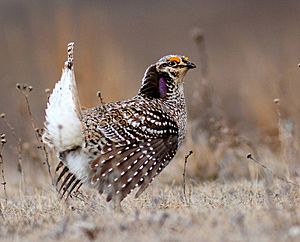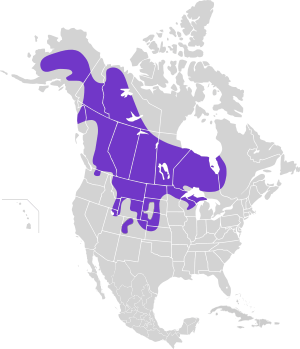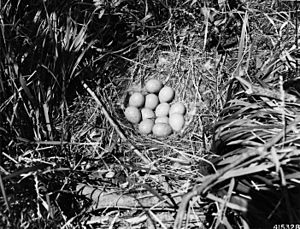Sharp-tailed grouse facts for kids
The sharp-tailed grouse (Tympanuchus phasianellus), also called the sharptail, is a medium-sized bird that lives on the prairies. It is a type of grouse.
Quick facts for kids Sharp-tailed grouse |
|
|---|---|
 |
|
| Conservation status | |
| Scientific classification | |
| Genus: |
Tympanuchus
|
| Species: |
phasianellus
|
 |
|
| Synonyms | |
|
|
Contents
About the Sharp-tailed Grouse Family
The sharp-tailed grouse belongs to a group of birds called Tympanuchus. This group also includes the greater prairie chicken and lesser prairie chicken. All these grouse types are found only in North America. The full scientific name for the sharp-tailed grouse is Tympanuchus phasianellus.
There are six types (subspecies) of sharp-tailed grouse that are still alive today, and one that is now extinct. Here are the living ones:
- T. p. phasianellus: Found in Manitoba, northern Ontario, and central Quebec. It sometimes moves to different areas.
- T. p. kennicotti: Lives in the Northwest Territories, Canada from the Mackenzie River to the Great Slave Lake.
- T. p. caurus: Lives in north-central Alaska, extending east to the southern Yukon, northern British Columbia, and northern Alberta.
- T. p. columbianus: Found in small areas of Idaho, Wyoming, Colorado, Utah, and British Columbia.
- T. p. campestris: Lives in Saskatchewan, southeastern Manitoba, southwestern Ontario, and parts of Michigan, Minnesota, and Wisconsin.
- T. p. jamesi: Lives in the northern Great Plains in southern Alberta and Saskatchewan, eastern Montana, North and South Dakota, Nebraska, and northeastern Wyoming. This type prefers mixed-grass prairies.
The T. p. hueyi type from New Mexico is now extinct.
What Sharp-tailed Grouse Look Like
Adult sharp-tailed grouse have a short tail. The two feathers in the middle of the tail are square-tipped and a bit longer than the others. This gives them their special name. Their feathers are a mix of dark and light browns on a white background. Their bellies are lighter and have faint "V"-shaped marks. These "V" marks help tell them apart from prairie chickens, which have strong bar patterns on their bellies.
Male sharp-tailed grouse have a yellow comb above their eyes. They also have a purple patch on their neck that they show off. This purple patch is another way to tell them apart from prairie chickens, whose neck patches are yellow or orange. Females are smaller than males. Their tail feathers have regular horizontal lines, while males have irregular lines. Females also have less noticeable combs.
Measurements:
- Length: 15.0 to 19.0 inches (38.1 to 48.3 cm)
- Weight: 21.0 to 31.0 ounces (596 to 880 grams)
- Wingspan: 24.4 to 25.6 inches (62 to 65 cm)
Where Sharp-tailed Grouse Live
Before European settlers arrived, sharp-tailed grouse lived in eight Canadian provinces and 21 U.S. states. Their range stretched from Alaska in the north, down to California and New Mexico, and east to Quebec, Canada.
After European settlement, sharp-tailed grouse disappeared from several states. These include California, Kansas, Illinois, Iowa, Nevada, and New Mexico.
Behavior and Daily Life
What Sharp-tailed Grouse Eat
These birds look for food on the ground during summer. In winter, they find food in trees. They eat seeds, buds, berries, and leaves. In summer, they also eat insects, especially grasshoppers.
Reproduction and Life Cycle
Sharp-tailed grouse are "lekking" birds. This means males gather in open areas called leks to perform special dances and attract females. A lek can have just one male or up to 20, but usually around 8 to 12.
In spring, from March to July, male sharp-tailed grouse go to these leks. The busiest time is usually late April or early May, but this can change with the weather. Males dance by stomping their feet very fast, about 20 times per second. They also rattle their tail feathers while turning in circles or dancing forward. They inflate and deflate their purple neck sacs. Males also make "cooing" sounds to attract females and compete with other males.
Females choose one or two of the strongest males in the middle of the lek. After mating, the female leaves to build a nest and raise her young by herself.
Where Sharp-tailed Grouse Live and Why
Sharp-tailed grouse live in different prairie areas across North America. They can be found in pine forests with open grassy areas in the Midwest, and in short-grass or shrubby prairies in the Great Plains and Rocky Mountains. The type of habitat they choose depends on how good the available habitat is.
Generally, they prefer open prairie areas with lots of grass and some patches of shrubs. They don't like too many tall trees. This kind of open, grassy habitat is used all year round for different reasons, such as dancing, nesting, raising chicks, and staying warm in winter.
Lekking Habitat
The lek, or dancing ground, is usually a flat area with short, native plants. They also use farm fields, recently burned areas, mowed spots, or grazed hilltops. Males like to choose high places like hilltops or ridges. This helps them see other males, approaching females, and any predators. If too many tall plants or trees grow around a lek, the males might leave it.
Nesting Habitat
Nesting areas are very important for female sharp-tailed grouse. They need dense, tall plants from the previous year's growth, often with some woody shrubs nearby. This helps hide their nests. Some studies show that females choose shrubby areas for their first nests because shrubs offer good cover early in the breeding season.
Brood Rearing Habitat
Sharp-tailed grouse chicks are "precocial." This means they hatch with their eyes open and can move around and feed themselves soon after birth. The mother doesn't need to feed them. After hatching, the chicks and mother leave the nest to find cover and food.
Brood rearing habitats have several features:
- Shrubby plants for hiding from the sun and birds of prey.
- Short plants nearby for easy feeding.
- Lots of different flowering plants (forbs).
This is why grouse often nest in or near shrubby areas. Young grouse need open areas with plenty of insects to eat and green plants for the mother. They use shrubby areas for safety and shade, but stay close to good feeding spots with shorter plants.
Winter Habitat
In winter, sharp-tailed grouse look for denser cover to stay warm. They often use thicker areas at the edge of forests or shelterbelts (rows of trees planted for protection). If they are in open areas, they usually stay close to thicker cover. They might also use grain fields for food.
When there's a lot of snow, they move from open prairies and farm fields to shelterbelts and woody areas. Sometimes, grouse will even burrow into large snow banks to keep warm during cold nights.
Why Sharp-tailed Grouse Numbers Are Declining
One of the main reasons sharp-tailed grouse numbers are going down is habitat fragmentation. This means their natural homes are being broken up into smaller, separate pieces. This happens for several reasons:
- Natural changes: Shrubby grasslands can slowly turn into forests if fires are stopped.
- Human activities: Planting trees, limiting logging, and the spread of invasive woody plants also break up their habitat.
- Agriculture: The biggest reason for habitat loss is farming. In the past, large areas of prairie were plowed for crops, changing the land forever.
- Overgrazing: Too many cattle grazing in one area can also harm the grouse's habitat if not managed carefully.
During the "Dust Bowl" years in the 1930s, many farms were abandoned. The government bought this land and sometimes planted non-native plants like smooth brome and crested wheatgrass. While these plants helped protect the soil, they grew very fast and pushed out the native plants. Sharp-tailed grouse prefer areas with many different types of plants, not just one kind (monoculture).
Helping Sharp-tailed Grouse Survive
Scientists and land managers use different methods to understand and protect sharp-tailed grouse habitat. In the past, they just looked at where birds were found. If more birds were in one spot, they thought it was better habitat.
Now, they use tools like the Robel pole to measure how tall and dense the plants are. This helps them figure out if an area is good for grouse. For example, for nesting, sharp-tailed grouse prefer areas where the plants are at least 4 cm (about 1.5 inches) tall. For good nesting, the average plant height should be around 8.89 cm (3.5 inches).
Land managers use these measurements to decide how many cattle can graze in an area. This helps make sure there's enough plant cover left for the grouse. Lekking areas can be managed by burning, mowing, or grazing to keep them open and free of tall woody plants. Too many trees near leks can scare away the males, possibly because trees offer perches for predators.
Provincial Bird
The sharp-tailed grouse is the official provincial bird of Saskatchewan, Canada.
Status and Conservation
The number of sharp-tailed grouse is decreasing, and their range is shrinking because of habitat loss. However, overall, they are not yet considered a threatened species.
See also
 In Spanish: Gallo de las praderas rabudo para niños
In Spanish: Gallo de las praderas rabudo para niños





